How the AMC Eagle blazed a trail through a giant government loophole
On a rainy day in 2015, I had the chance to test drive an AMC Eagle up the side of a small mountain in Pennsylvania. I’m not a skilled off-roader, but the car conquered the washed-out gravel roads and muddy two-tracks with ease. Not once did this 30 year-old station wagon get stuck or even spin its wheels.
When new, the Eagle was an interesting mix of an outdated body and an old engine coupled to a groundbreaking four-wheel-drive system. AMC fans love bragging that the Eagle was the first four-wheel-drive car and the first crossover SUV. In response, I can’t help thinking of an often misquoted but apt meme:

The Subaru Leone offered four-wheel-drive in 1972, the Jensen FF had it in 1966, and the GAZ M-72 had it way back in 1955. At best, the 1980 Eagle could be called the first American four-wheel-drive car. But if we accept that as true, how could the AMC also be the first crossover SUV? A car and a crossover are not the same.
Now, I don’t mean to start a big debate, but I consider a crossover to be a vehicle built on a car platform but with styling that mimics traditional truck-based SUVs. A crossover is not just a lifted car with all-wheel drive. By that metric, the Audi Allroad and Volvo Cross Country aren’t crossovers, because they share body panels with their wagon siblings, but the Audi Q5 and Volvo XC60 are crossovers.
The Eagle’s body panels were virtually identical to those of the AMC Concord, and it came in sedan, wagon, and hatchback forms. The AMC may be lifted, with four-wheel drive and a bunch of plastic cladding, but it still shares its body and interior with a line of passenger cars. I have long thought of the Eagle as a four-wheel-drive car, not a crossover.
That is, until I discovered the Eagle’s original 1977 product proposal.
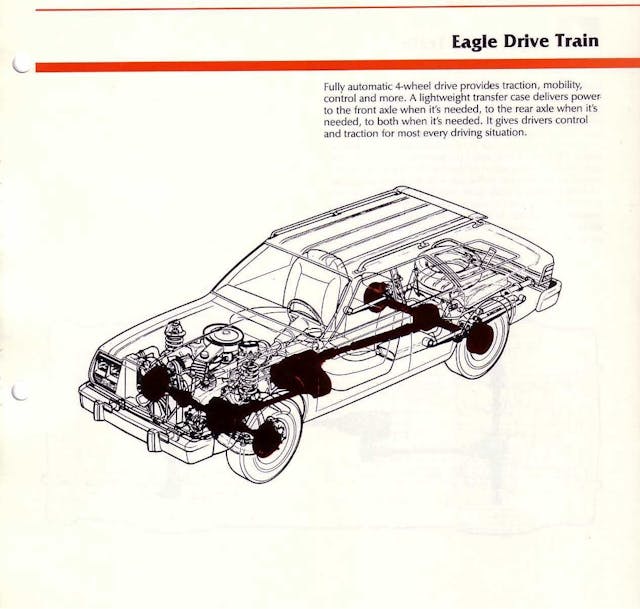
After American Motors acquired Jeep from the Kaiser Corporation in 1970, it hired Roy Lunn to run Jeep engineering. A British expat who had worked on the Ferrari-beating Ford GT40, Lunn was tasked with updating Jeep’s outdated products, but he also looked into the feasibility of a four-wheel-drive passenger car. In 1972, he cobbled together an AMC Hornet with a Jeep Quadra-Trac drive system. The combination worked, but the Jeep system produced unacceptable levels of noise and vibration, exacerbated by the car’s unibody construction. With plenty of demand for existing AMCs and Jeeps, American Motors shelved the project.
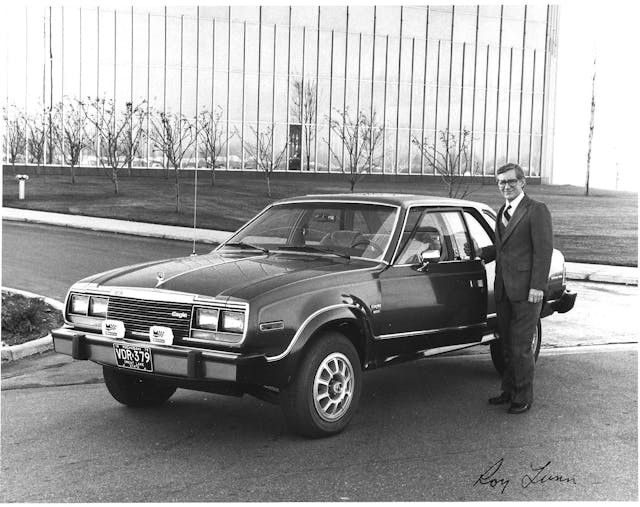
In 1976, Lunn learned about a viscous-coupling transfer drive developed by FF Developments and GKN and said to offer a quieter and smoother form of four-wheel drive. The Quadra-Trac system transferred power through a limited-slip center differential with a metal-on-metal connection. The FF-GKN viscous arrangement used a coupling that featured a series of discs spinning in a silicone-based fluid. Lunn hoped the technology would solve the four-wheel-drive Hornet’s issues with noise, harshness, and vibration.
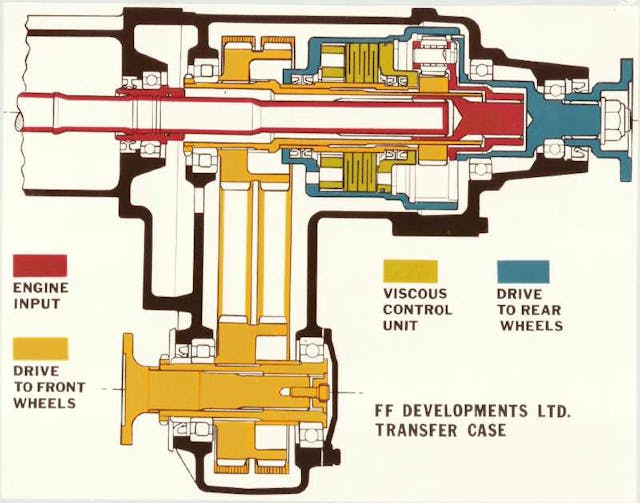
Lunn quietly asked management for a million dollars to restart the project and build another prototype. The inquiry was a direct violation of company policy—American Motors believed new vehicle ideas were the job of product planners, not engineers. Lunn managed to get the money without getting fired, however, and immediately got to work with FF, GKN, and New Process Gear, the viscous technology’s American rights-holder. By June of 1977, FF had built a prototype four-wheel-drive Hornet in England and shipped it to the States. In July, Lunn presented his reworked idea to AMC’s board of directors.
Although he was an engineer, Lunn had noticed an increasing disconnect between the way Jeeps were marketed and the customers who actually bought them. Writing years later in a technical paper for the Society of Automotive Engineers, he said:
“It was evident that many consumers coming from the 2WD segments were buying the vehicles (Jeeps) for the security they offered for on-highway driving, although the only vehicles available were accented to off-road usage. This out-of-context purchase, particularly in high volumes, raises the question of whether there was a need for a new type of vehicle with a different balance of compromise accented to highway usage.”
In other words, “The commercials show people driving up mountains, but in real life, they only go to the grocery.”
In today’s world, as we drive around surrounded by mall-crawling SUVs, that conclusion seems obvious. But in the mid-1970s, automakers were slow to realize the trend. Then as now, most Jeep buyers weren’t hardcore off-roaders; they wanted extra traction “just in case” of rain, snow, or slush. Four-wheel-drive cars were rare. A Jeep Wagoneer or Cherokee might be overkill, but it was still more practical for a family than a pickup truck.

By 1977, AMC’s passenger-car sales and fortunes were sinking fast. Lunn’s product proposal, titled “8001 Plus Four,” was remarkably clear-eyed:
“American Motors has functioned most-profitably in situations where its products were unique in the marketplace. The current passenger-car decline is unquestionably partially due to a demand for larger vehicles; but our disproportionately low share of the small-car market is highly influenced by increasingly superior imports and domestic competition.
The ongoing product situation, particularly relating to emissions and fuel economy legislation, is also necessitating complete redesign of basic vehicles to meet a new market created by standards rather than customer demand or desire. AMC is not financially or creatively capable of being able to meet this changing situation in the main segments of the market. We have, therefore, to accept progressive annihilation or get back to where we started by finding unique slots in the marketplace which are legal on a continuing basis and are within our financial and creative capabilities. This product proposal relates to creating such a unique product as a natural combination of Jeep and Passenger Car factors.”
None of the above was earth-shattering; AMC was getting squeezed by imports in the compact market and by the Big Three in the full-size market. The company desperately needed a fresh product in a niche with less competition. As Lunn said, a four-wheel-drive car was “a natural combination,” and basing that vehicle off an existing design or designs would save AMC millions.
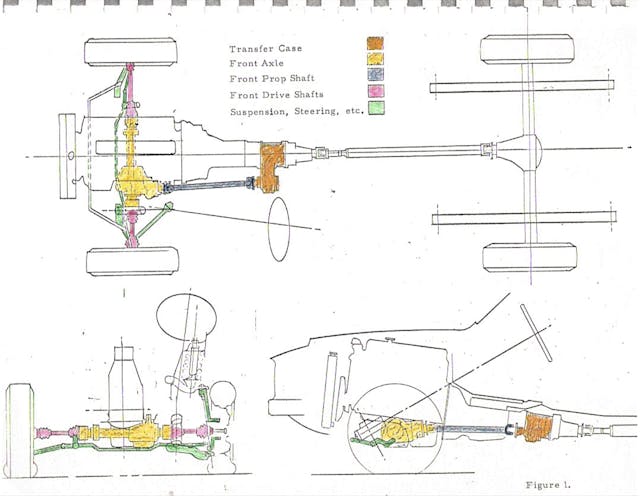
Here’s where it gets interesting: Lunn argued that AMC lacked the resources to meet upcoming government standards. Corporate Average Fuel Economy (CAFE) rules were set to go into effect in 1978 and grow more strict every year after. Emissions and safety standards were increasing, too. But Lund had devised a clever way around that:
“A most important aspect of the proposal is the legal categorizing to meet safety, fuel economy, and emission standards. The specification content and package layout are designed such that the vehicle would be categorized as follows:
- Safety—multi-purpose
- Fuel Economy—non-passenger cars (starts in 1979 at 17.2 mpg)
- Emissions—Light truck
These categories have obvious and distinct advantages over passenger-car requirements. This will enable us to pursue a course of action which will require less change to our basic powertrains and maybe a lower level of [emissions] control equipment.”
Roy Lunn said it first: The Eagle is not a car! And it was the first vehicle to exploit the “SUV loophole.”
Hagerty video host Jason Cammisa has a detailed and entertaining description of that term, but the loophole is essentially an unintended consequence of various American automobile regulations passed in the 1960s and 1970s. The majority of Americans at the time drove “passenger cars” (sedans, station wagons, coupes, hatchbacks, etc.), so the government made fuel economy, emissions, and safety regulations for these vehicles considerably stricter than those for “light trucks” (pickups, SUVs, off-road vehicles).
Those regulations were partly the result of corporate lobbying and partly just well-intentioned policymaking. Their goal was to cut trucks a bit of slack in fuel use, because those vehicles made up a smaller part of the market and needed more powerful engines for towing and hauling. Regardless, as with all well-intentioned rules, people found a way to skirt them.
By meeting the class specifications of a light truck, a vehicle would have more lenient engineering requirements and lower development costs. As a result, trucks and SUVs would become more profitable to build, so automakers spent more money designing and marketing them.
Those regulations unintentionally created a self-reinforcing feedback loop that helped truck and SUV sales skyrocket. The trend continues today and has contributed to all kinds of issues, from increased pedestrian deaths to increased air pollution. This isn’t the place for a political discussion, but no matter how you slice it, it’s funny that the United States government puts a Subaru Crosstrek in the same category as a Ram 1500, when it’s really just a lifted Subaru Impreza hatchback.
Those rules made sense back when SUVs were actually based on truck chassis—and when they were primarily used for towing, hauling, and off-roading. But now, and even more so than in Roy Lunn’s time, the majority of SUV drivers never even scratch the surface of their vehicle’s ability. Instead, automakers continually push the envelope for which car-like vehicles can technically be classified as SUVs. By this metric, perhaps the AMC Eagle was the first crossover after all.
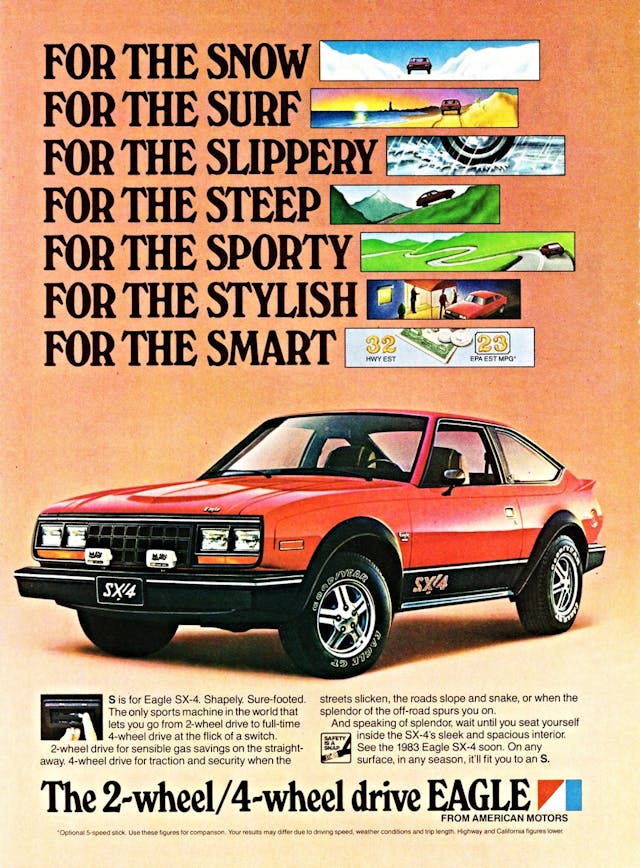
AMC’s board approved Roy Lunn’s proposal, and the Eagle, as planned, was classified by the government as a light truck. Although the prototype was based on a Hornet, the Hornet was revamped into a new model, the Concord, for 1978. As a result, when the Eagle debuted in 1980, it used Concord bodies, with minor changes like fender flares and a different grille. The advanced viscous-coupling drive system was an industry first, and it later made its way into several Jeep products, including the XJ-chassis Cherokee.
Who could blame AMC or Lunn for taking advantage of the loophole? No one could have predicted the crazy consequences these regulations would have on the automotive landscape. Ironically, I think Lunn saw the Eagle as a less wasteful alternative to other trucks and SUVs.
Compared to those, the AMC was smaller, more fuel-efficient, and easier to drive. It was supposed to convince people to trade in their gas-guzzling Wagoneers, not their family sedans.

In light of all this, I still hesitate to call the Eagle a crossover SUV, despite what the government says. The term crossover didn’t even exist at the time, and most AMC marketing cagily refers to the Eagle as a “vehicle,” “automobile,” or “sport machine,” although sometimes the word “car” slips through.
Regardless of semantics, Roy Lunn and American Motors should be commended for the creativity it took to develop and launch such a revolutionary vehicle on such a small budget. More importantly, Lunn should be remembered for engineering an incredible 4WD system that still holds up after 30 years, and there’s no debate about that.
Joe Ligo is the director/producer of the “The Last Independent Automaker,” a documentary TV series about the history of American Motors Corporation.
***
Check out the Hagerty Media homepage so you don’t miss a single story, or better yet, bookmark it. To get our best stories delivered right to your inbox, subscribe to our newsletters.

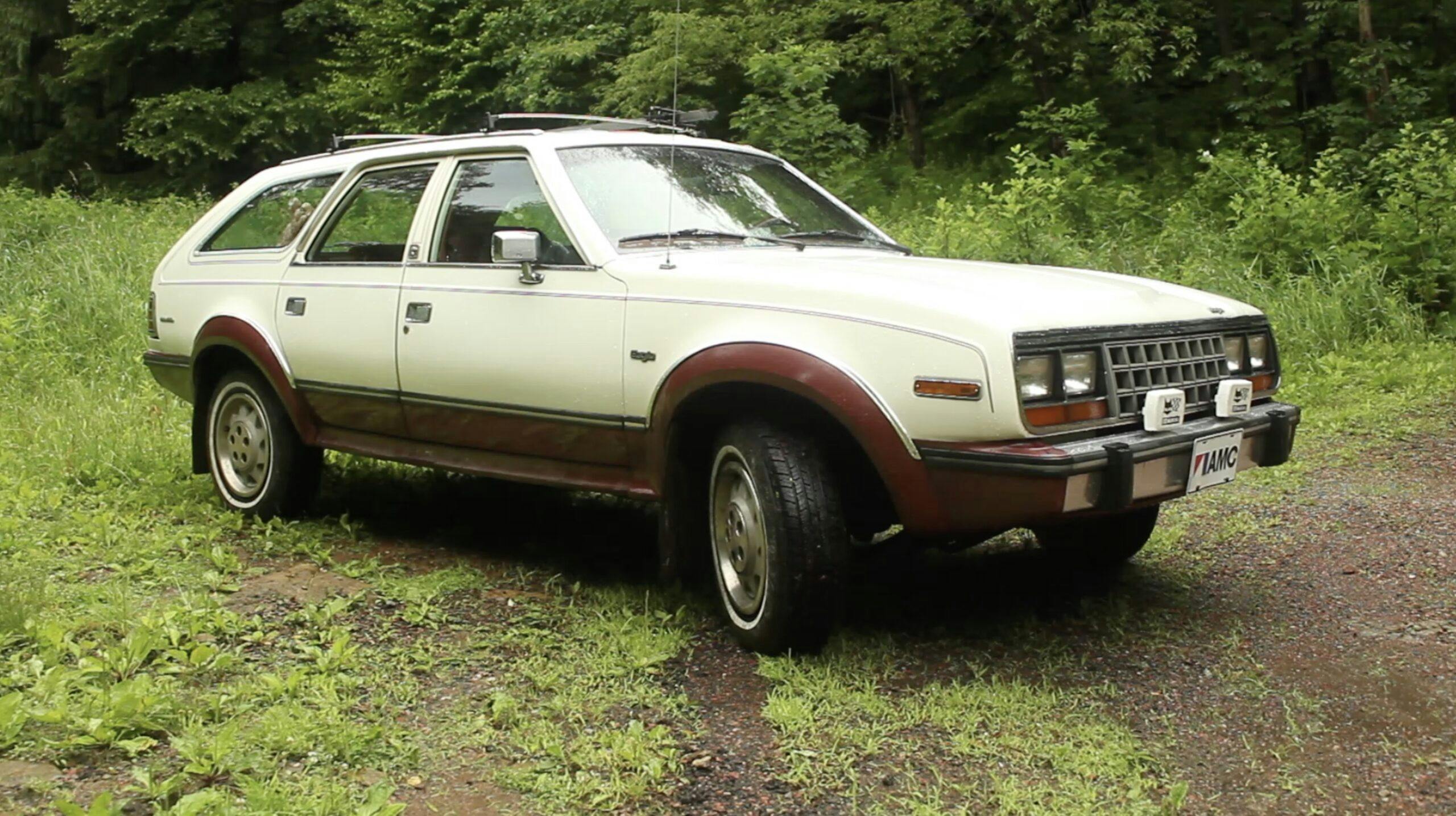
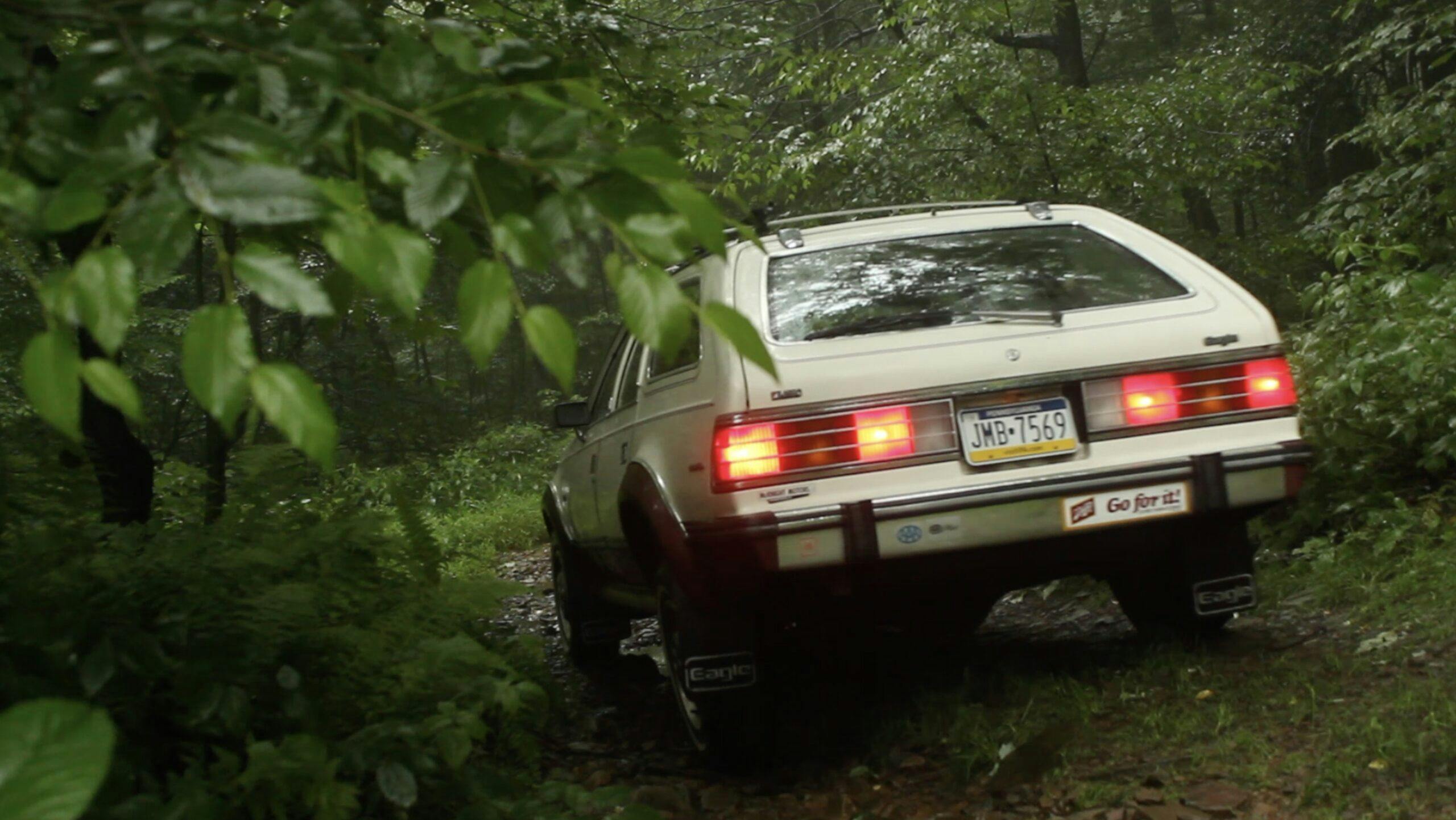

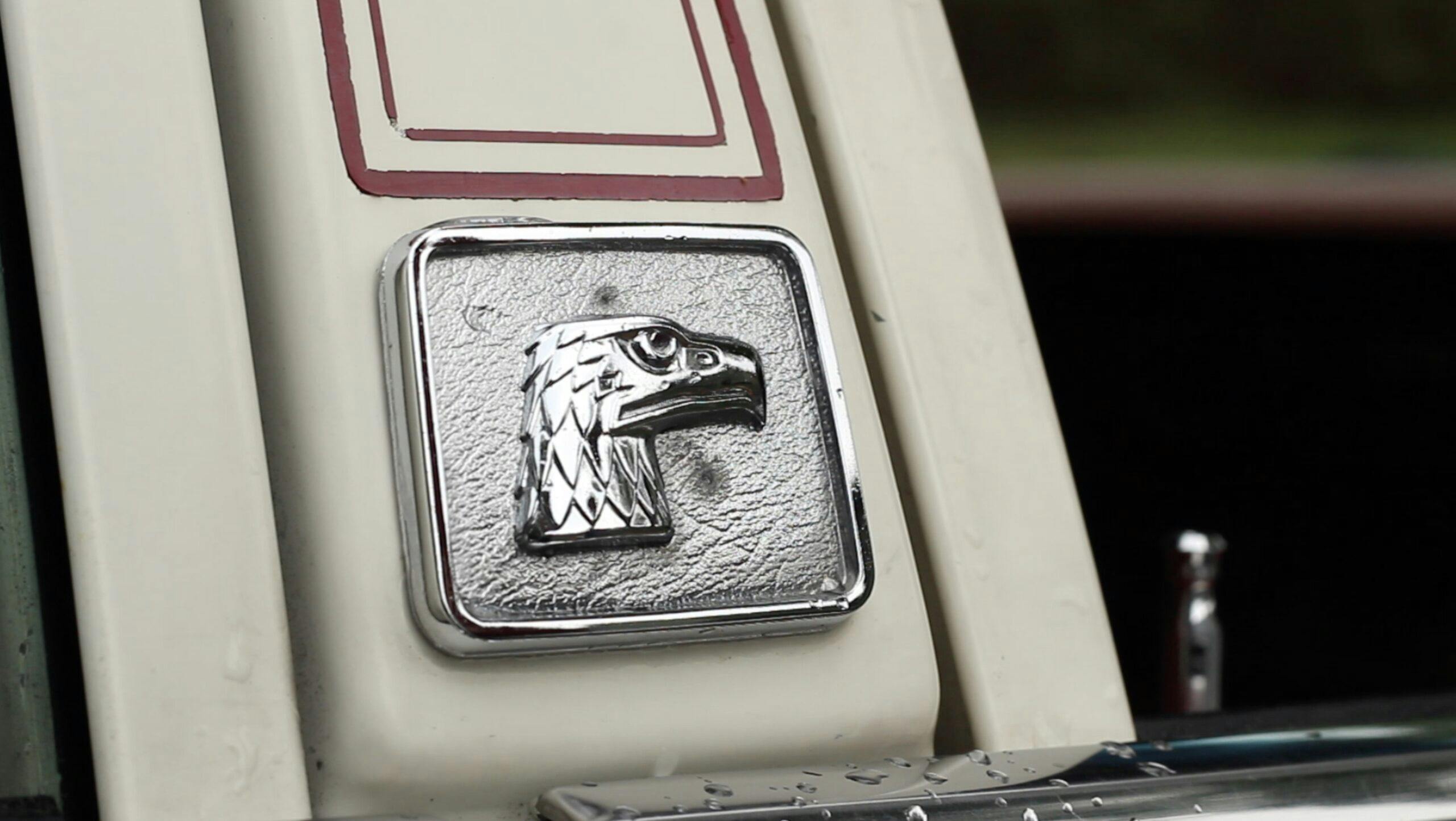
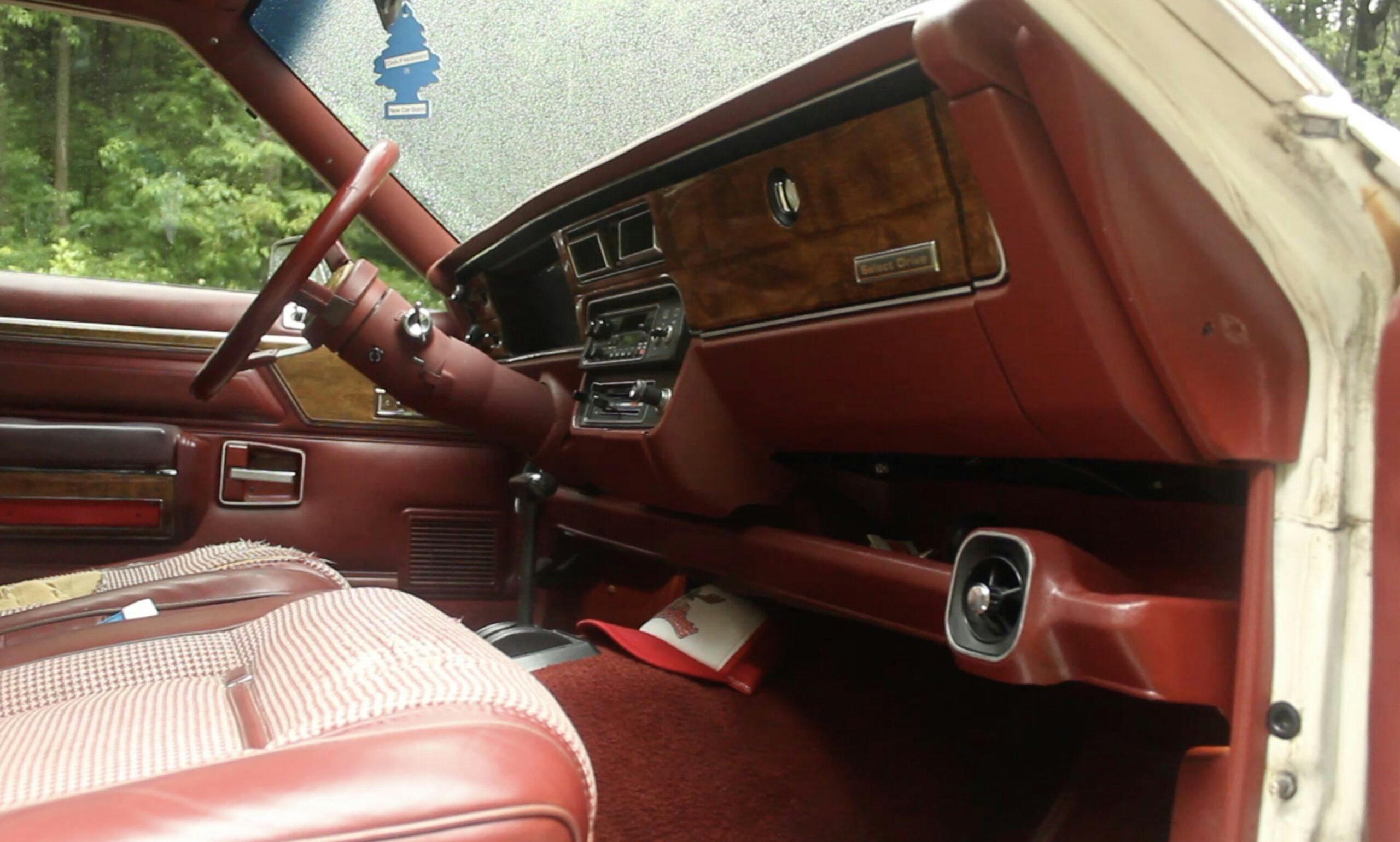

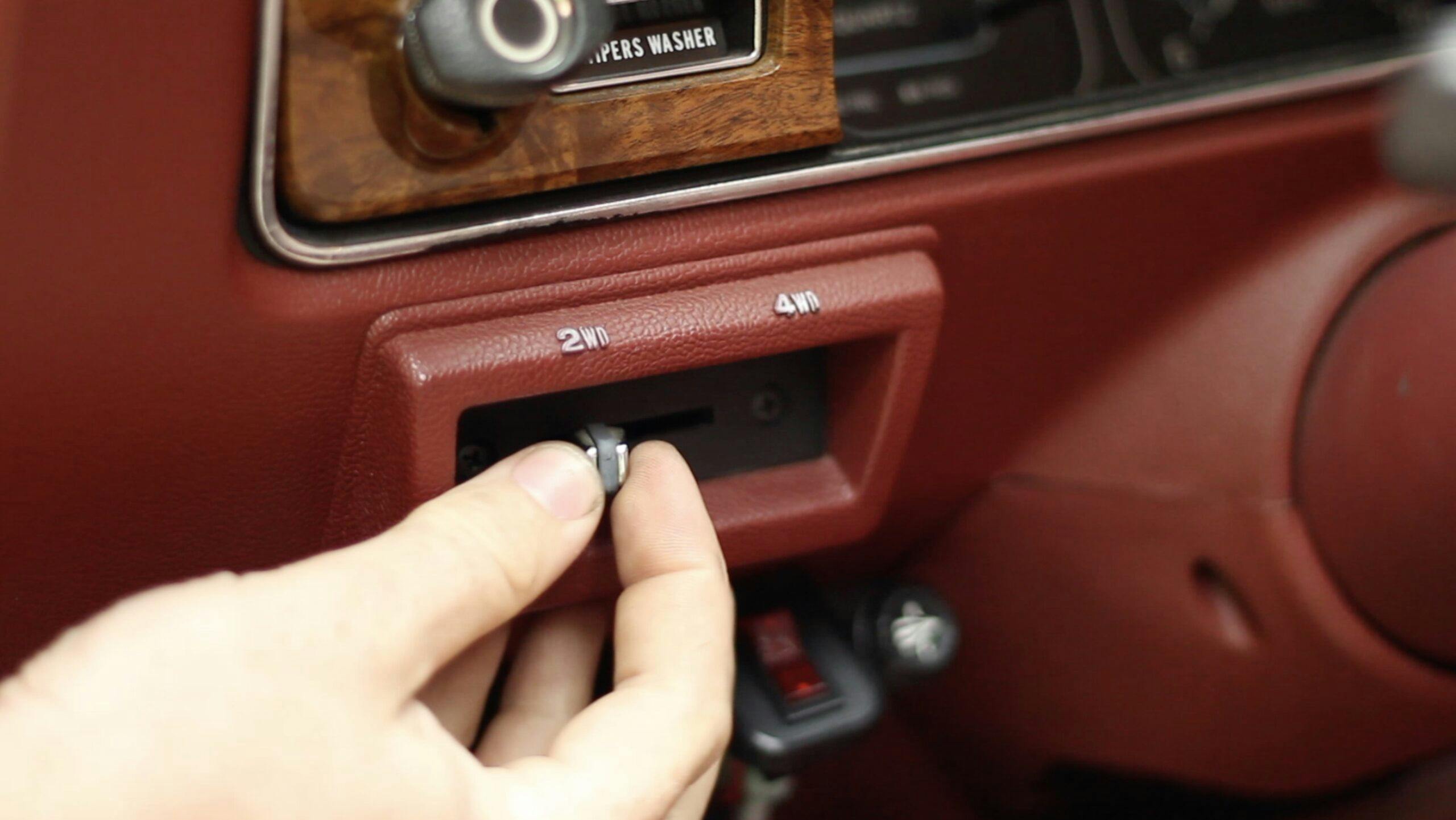

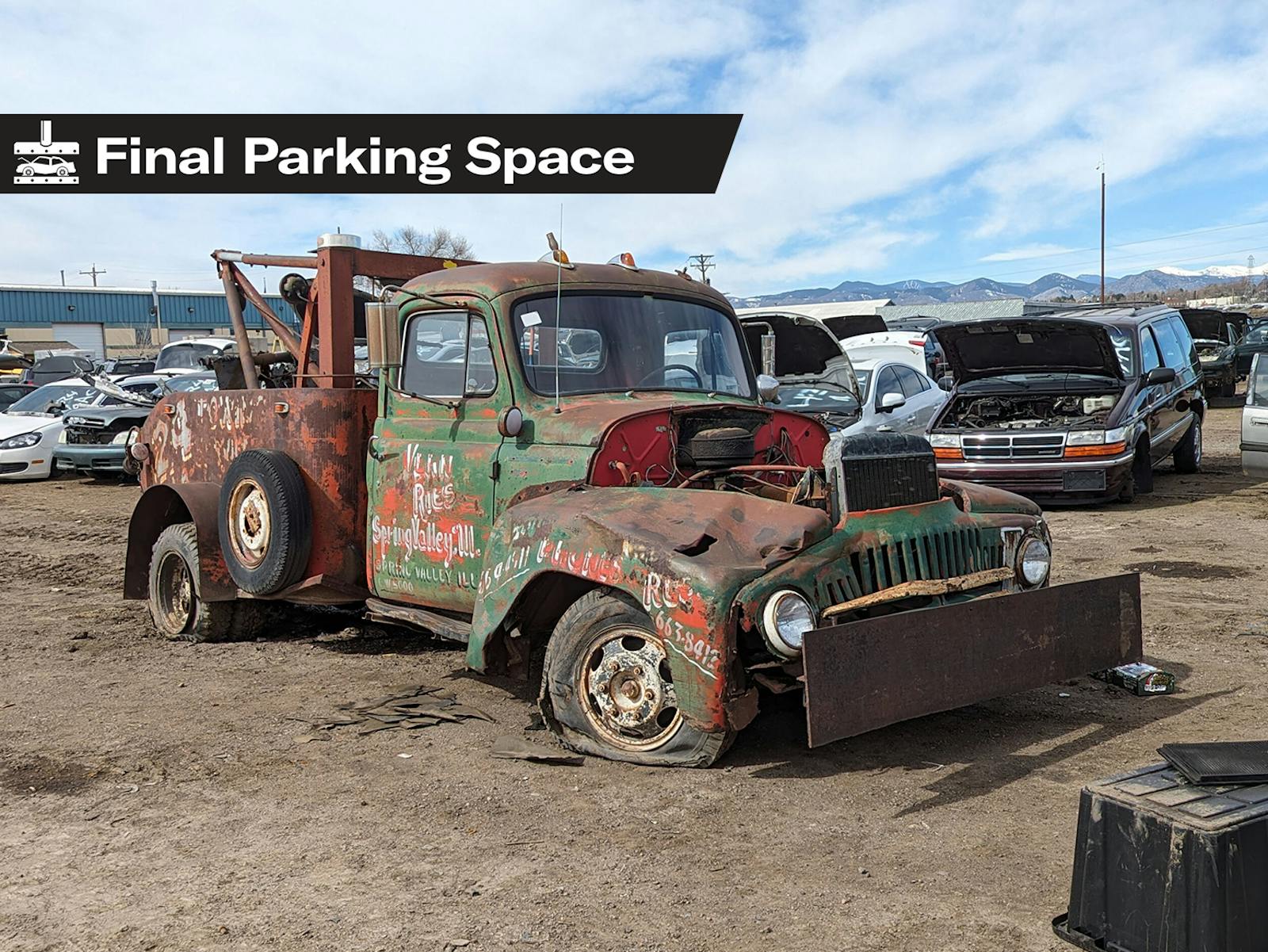
I would basically side towards a crossover SUV also. It had a real 4WD system, not AWD. Most crossovers today are AWD tall wagons / cars so to me they are not SUV’s.
In 1980 they had AWD. Except for a few strays they all became select drive in 1981. I have one of each in the 2 door sedan variety.
Great story! Would like to contact Joe Ligo as I am writing a book about Roy Lunn’s legacy and have a question about one of the photos.
Good and informative story!
I found it rather annoying that the article was more about how to classify the Eagle as opposed to being more informative about the car itself.
I owned a 1986 model wagon. Like many others, I found the styling to be less than attractive.
Here in Michigan I needed to get my vehicle emission checked.
While I was at the service center the proprietor told me I should take this Eagle wagon he had for sale on a test drive.
I really had no interest, but the offer beat sitting around waiting while I complied with state regulations.
The car actually drove pretty nice, nicer than I expected! During the drive, I noticed the car had just under 100,000 miles on the odometer and it was only two years old. When I returned from my test drive, the ever vigilant salesman asked me “What did I think of the car?”
Then he asked “How much do you think a car like that is worth?”
I really wasn’t in the market for a car – but his price was attractive. I returned home and told my wife of the experience. She opined that she would be interested in owning the Eagle. So it came to be ours.
Usually my cars eventually suffer from rust and must be replaced. The Eagle lasted us for 15 years of service before we let it go. By that time the Torqueflight transmission was leaking fluid at the front seal and the engine had noticeable blow-by. However, the body had no noticeable rust.
As time has gone on, I wish I could have retained the Eagle and done those repairs.
The car was adequate as far as power, however the emission tuning was a real compromise.
I suspect the lean tuning was a factor in the upper cylinder wear.
The revised motor with fuel injection as used in the Cherokee would have made the Eagle very nice indeed!
My sister showed up one day with a Subaru. It was about 4 years old and she asked me to go for a ride to try to hear the noise coming from the rear of the vehicle. The rear end was screaming like a Banshee. She had bought it used from someone in Vermont when it was 3 years old and after a year of her ownership, the bottom third of all 4 doors was gone…rusted away. That coupled with the howl coming from the drivetrain was why I recommende that she buy a new car and send that one to the shredder. The hippies had given up on their SAABs and Volvos and were buying Subarus so they could safely get to their cabins in the mountains. That turned out to be why Vermont’s salty roads proved to be their undoing. They were designed to drive in Tokyo, not Burlington. You could drive them through the snow, but the frigid wind blew through the holes in the body.
I guess we can blame AMC for convincing people that they need a 5000 pound 4 wheel drive truck to get to the grocery store. That a good reason why we celebrate the demise of AMC. The environmental people think they are saving the planet by using up 5000 pounds of raw materials, and twice as much rubber, and 30% more fuel, as a regular car.
Most of us don’t celebrate the demise of AMC. We also don’t come here to act sanctimonious, either.
The Eagle sneaked through a loop hole, broke down and died there.
I had a 1981 Eagle Kammback (Gremlin w/ 4 wheel drive) in 1988.
It had the Iron Dook four banger, a four speed BW transmission and all time 4WD. Top speed was 60 mph, downhill, with a tail wind nad a push.
The Eagle never got stuck in the snow or sand, but it did spend a lot of time not running, starting and falling apart. I learned to park facing downhill so it was easier to push start.
The six cylinders were magnificent engines, if you kept them in tune. Did you not do that?
You missed the part about the Iron Duke.
My mistake.
I had 3 cars with iron Dukes. A Chevy Monza, a Celebrity, and a Blazer. They worked fine for me.
I miss AMC.
I had an Eagle 2 dr 4 spd as a company car in 80 or so
Really liked it.
Good article
Now on my fourth Outback so
I guess the seed was planted by the eagle.
Most useful vehicle I ever owned. Drivetrain was good. Everything else not so good. I remember that the air conditioner seemed like it was after market for a 1940s car. It hung under the dash but was factory.
I could NOT kill my 83 eagle wagon. GAVE it away…..that person got their use of it then DROVE it to the junkyard.
I believe that loophole has been tightened but it remained for years. As I understand it, the Dodge Magnum wagon (2005-2008) was classified as a “light truck” for emissions and CAFE regulations.
I thought they looked good with the 4wd stance. Like ready to pounce on the road.
It’s Aardman Animation, not Armand. Otherwise great article.
I seriously considered buying one in 1979 because I lived out in the country in the snow belt. My step sister had already bought one and when I talked to her and her husband they weren’t to fond of it with the problems they had with it and the local dealer service. Ended up buying a Ford 4X4 instead as the dealer was just 12 miles away instead of 30.
Noted in photo credits Doug Shepard- I had the brief pleasure of working for Doug Shepard at a start-up called Bright Automotive. THAT Doug Shepard had been the SCCA Pro Rally winning codriver with John Buffum in factory Audi Quattros in the 1982 season- an accomplished engineer, he knew a thing or two about 4-wheel drive performance cars.